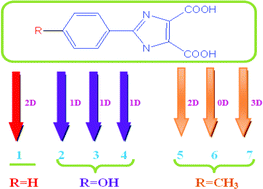Seven metal–organic frameworks, [Sr(PhHIDC)(H2O)]n (PhH3IDC = 2-phenyl-1H-imidazole-4,5-dicarboxylic acid) (1), {[Mn(p-OHPhHIDC)(H2O)2]·H2O}n (p-OHPhH3IDC = 2-(p-hydroxylphenyl)-1H-imidazole-4,5-dicarboxylic acid) (2), {[Cd2(p-OHPhHIDC)2(phen)2]·H2O}n (phen = 1,10-phenanthroline) (3), {[Cd2(p-OHPhHIDC)2(2,2′-bipy)2]·H2O}n (2,2′-bipy = 2,2′-bipyridine) (4), [Sr(p-MePhHIDC)(H2O)]n (p-MePhH3IDC = 2-(p-methylphenyl)-1H-imidazole-4,5-dicarboxylic acid) (5), [Cd4(p-MePhHIDC)4(py)7(H2O)] (py = pyridine) (6) and {[Co1.5(p-MePhIDC)(H2O)3]·H2O}n (7) have been synthesized under hydro(solvo)thermal conditions. X-ray single-crystal analyses reveal that they have rich structural chemistry ranging from zero-dimensional (0D) tetranuclear complex (6), one-dimensional (1D) polymers (2, 3 and 4), two-dimensional (2D) polymers (1 and 5) to three-dimensional (3D) polymer (7). In these complexes, the imidazole dicarboxylate ligands show strong coordination ability and various coordination modes, which are consistent with the theoretical prediction of the substituent (phenyl, p-hydroxylphenyl or p-methylphenyl groups) effect of PhH3IDC, p-HOPhH3IDC or p-MePhH3IDC ligands, respectively. The thermal properties and photoluminescence properties of compounds 1–7 have been investigated as well.


 Please wait while we load your content...
Please wait while we load your content...